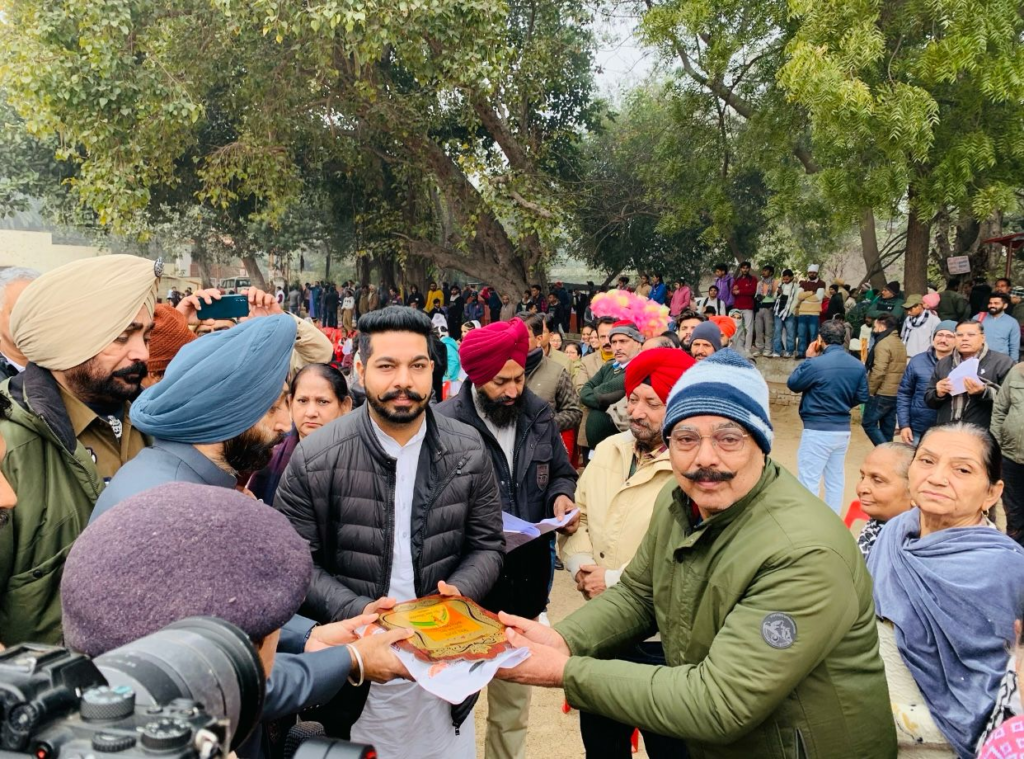1) New Year( Welcome 2024)
As we joyfully embrace the arrival of 2024, it’s time to look back on the challenges conquered and express our heartfelt appreciation for the unwavering support from our cherished ones. Let’s extend our gratitude to those who stood by us in the past year and welcome the opportunities and adventures that 2024 has in store.

2) GLOBAL FAMILY DAY
Global Family Day, also known as World Peace Day, is celebrated every year to promote the concept of harmony and unity in the world. Furthermore, it emphasizes the idea of the world as a global village in which we are all family, regardless of citizenship, borders, or race.
It all started in 1997 when the United Nations General Assembly launched the International Decade for the Culture of Peace and Non-Violence for the Children of the World — as of the first day of the new millennium. Linda Grover was a key figure in promoting this in the U.S. and other efforts to promote it included books such as “One Day in Peace – January 1, 2000”. This book revolved around the concept of a day in the future where there is only peace and no war.
However, this was just the beginning of a new peaceful world and, in 1999, all U.N. member states received an invitation to formally dedicate the first day of that particular year to develop strategies towards peacebuilding. Seeing the positive impact of the day, Global Family Day was declared an annual event by the U.N. in 2001.

Global Family Day is an annual event celebrated on the first Sunday of January. It is a day to commemorate the importance of family and to recognize the bonds that unite us all. The day is intended to bring people together from all walks of life, regardless of race, religion, or nationality, to celebrate the significance of family and to recognize the importance of family in our lives.
On this day we recognize the importance of family for providing us with emotional, physical, and financial support in times of dire need. Global Family Day is an opportunity for people all around the world to acknowledge the unique and valuable contributions that families make to society.
WHY GLOBAL FAMILY DAY IS IMPORTANT
- It reminds us that we are one big family No matter which part of the world we reside in, the fact is, we are all human beings with hearts flooded with love. Our differences have been created by politicians and it’s days like Global Family Day that remind us how connected we are.
- It works towards ending discrimination Global Family Day is essential since it highlights that people of all races, religions, and countries are one. By celebrating it every year, we ingrain a message of peace in the younger generation.
- It can ensure World War III never takes place By constantly drumming the message of peace into the youth, we are raising leaders who will oppose war and, in effect, ensure the mistakes of the past are never repeated.
Value of family for society: the importance of family for society is immense. Families provide a sense of stability and security, and they are the foundation of our communities and civilization.
They are the source of our values and beliefs. Families also provide a sense of belonging and identity, and they are the root of our culture and traditions. Families are indispensable for the development of healthy, productive, and successful individuals, and they are the cornerstone of our society.
Global Family Day – Significance: While it aims to promote the concept of harmony and unity, it also emphasizes the idea of a ’global village where everyone is the same, regardless of their color, background, or place of origin. when we dig a little deeper to understand the origin of Global Family Day, we came to know that it was given by the United Nations General Assembly in 1997 to mark Millennium celebration.
Family and mental health: Family and mental health are closely related. Mental health can be affected by family dynamics, such as communication, conflict resolution, and support. Family members can also provide emotional support and can help to manage stress, which has a positive impact on mental health. Family members can help to cope with depression by providing emotional support, listening without judgment, and helping to create a safe and supportive environment. Additionally, they help to identify signs of depression and provide resources for treatment. They provide support to make realistic goals, engage in activities that bring joy, and seek professional help when needed.
Lastly here are suggestions, what we can do on this day: The best way to observe Global Family Day is to spend the day with our families. On this day just plan random dinner together with friends and relatives especially with whom we have bitter relations and enjoy other family activities that stringent their bonds and promote peace in the family. you can try to camp together or cook together going for picnics, treks and many more.
3) National Birds Day 2024
From history to celebrations, here’s all that you need to know about the special day.

Birds are one of the most beautiful things in nature. They make our day better with their chirping, they fly overhead and make us happy and sometimes they are just too beautiful and colourful to just look at. But beyond this, they are also important parts of the ecosystem. They indicate information about their health and vitality, and it is high time that we join hands in protecting them and ensuring that they have a healthy nature to thrive in.
National Birds Day is celebrated every year to raise awareness about the birds that are captured, brutally treated or produced in captivity for financial gain and pleasure. It is illegal and morally wrong to hold birds or animals in captivity and we must work to ensure that they have a better life.
Since 2002, National Birds Day has been celebrated in America. This date was chosen because it also happens to be the day for the yearly Christmas Bird Count. The national holiday is observed in America where people join hands together to gain details about the quality and condition of the birds in the United States of America.
4) Death Anniversary of Lal Bahadur Shastri
The death anniversary of Lal Bahadur Shastri is commemorated each year on January 11, and he is remembered as a national hero in India. He died on 11 January 1966 in Tashkent, Uzbekistan, just a few days after leading India to victory in the Indo-Pakistan War of 1965.
Lal Bahadur Shastri Biography and Achievements
Lal Bahadur Shastri was the second Prime Minister of India, serving from 1964 to 1966.
He was born on October 2, 1904, in Mughalsarai, United Provinces, British India (now in Uttar Pradesh, India). His father was a school teacher, and Shastri received his early education at home before attending the local high school.
Shastri’s political career began in the 1920s, when he joined the Indian independence movement. He was arrested several times for participating in protests and was eventually imprisoned for over two years for his role in the Salt Satyagraha of 1930. After his release, he became active in the Congress Party and rose through the ranks to become a leader in the party.
As Prime Minister, Shastri is best known for his leadership during the Indo-Pakistan War of 1965. The war began after Pakistan launched a series of attacks on India in an attempt to annex the state of Kashmir. Shastri responded by ordering Indian troops to counter-attack, and the two sides eventually agreed to a ceasefire. Shastri’s leadership during the war earned him widespread respect, and he is remembered as a hero in India.
In addition to his leadership during the war, Shastri is also remembered for his domestic policies. He implemented several programs aimed at improving the lives of the poor and promoting economic development, including the “Green Revolution,” which increased food production in India. He also promoted the use of Hindi as the official language of the Indian government, and he encouraged the adoption of a simple and austere lifestyle.
Shastri died suddenly on January 11, 1966, while attending a conference in Tashkent (now in Uzbekistan). The exact cause of his death is not known, and there have been several conspiracy theories surrounding his death.
Famous Quotes by Lal Bahadur Shastri
- Jai Jawan, Jai Kisan”
(Hail the soldier, Hail the farmer)
2) “We believe in peace and peaceful development, not only for ourselves the but for people all over the world.
3) “Truth alone triumphs, not untruth.”
5) Must Listen😊(The choice in our hands)
6) The Republic Day of India: A Great National Festival
The word ‘Republic’ is used to denote that a country in which the supreme power is held by the people or their elected representatives (politicians) or by an elected or nominated President not by a permanent head like the King or queen of Britain. India is one of the important republican countries of the World. In India, the Republic Day is celebrated every year on 26th January in New Delhi with great pomp and pageant. The Republic Day is enthusiastically observed by citizens as one of the important national festivals of India. This national festival is also celebrated all over the country and all the administrative units like the capital cities, district headquarters, sub-divisions, panchayats and educational institutions with a lot of enthusiasm. The date 26th January, 1950 is one of the memorable days in Indian history as it was on this day the constitution of India came into force and India became a truly sovereign state. On that day, the people of India finally realized the dream of Mahatma Gandhi and the numerous freedom fighters those who fought for and sacrificed their lives for the independence of our motherland. The date 26th January of every year has been recognized as the Republic Day of India. The Republic Day is a national holiday of India to mark the adoption of the constitution of India and the transition of India from the British dominion to a republic on 26th January, 1950. This festival is always a solemn reminder of the sacrifice of the martyrs who dedicated their lives for the freedom movement and the succeeding wars. On the Republic Day, the independence pledge of nationalists is renewed. The Republic Day is without speeches. It is the only ceremony in which rhetoric is in the background and visuals are given priority. This national festival at Delhi and the state capitals revolves around the parade in which all the Defense, N.C.C., school children and cultural groups participate followed by a display of tableaux and folk dances. Before going to the subject, here we have to discuss briefly on the salient features of the constitution of India for which the Republic Day is celebrated throughout the country. Salient Features of the Constitution of India: After a grand struggle, India achieved her long-cherished freedom on 15th August, 1947.

The Independence Day, August 15th is celebrated to commemorate the birth of the world’s biggest democracy as a great national festival. Our freedom fighters made India free from British Dominion. Thereafter, we could become the ruler of our country. India was governed by a constitution, which was framed by the Britishers previously. It was the Lahore session of the Indian National Congress at midnight of 31st December, 1929, the congress President Jawaharlal Neheru announced the congress policy that µComplete Independence¶ was the goal of India. It was to be ³Complete freedom from British domination and imperialism´. In that historic session, Mahatma Gandhi also moved his famous resolution on ³Purna Swaraj´. The resolution on Purna Swaraj was passed by the congress on the last day of the year 1929. The tricolour National flag, signifying independence, was unfurled

by the Congress President Jawaharlal Neheru as the thunderous shouts of ³Inquilab Zindabad´ or long live the resolution greeted the occasion from countless throats. The 26 January, 1930 was initially observed by nationalists as the day of Purna Swaraj or Complete Independence. The nationalists also took the independence pledge on that memorable day. The pledge declared ³freedom as the inalienable right of the Indian people´ and criticized the foreign Government for ruling India. Arising out of Gandhi¶s serious thought, a pledge had been taken that every year on January 26, the Republican Day would be celebrated and that the people would unceasingly strive for the establishment of a Sovereign, Democratic Republic of India. Although, India achieved its independence on August 15, 1947, it did not have a permanent constitution. A Constituent Assembly had been entrusted with the task of framing a new constitution for free India. On August 29, 1947, the Drafting Committee was appointed to draft a permanent Constitution with Dr. B.R. Ambedkar as the Chairman. A Draft constitution was prepared by the Committee and submitted to the Assembly on November 4, 1947. The Assembly met, in session open to public, for 166 days, spread over a period of 2 years, 11 months and 18 days before adopting the Constitution. After many deliberations and some modifications, the 308 members of the Assembly signed two handwritten copies of the document (one each in Hindi and English) on January 24, 1950. Two days later, the Constitution of India became the law of all the Indian lands. The constitution of India came into effect only on 26th January, 1950. Following the date January 26 ,1950, Rajendra Prasad was elected as the President of India. This was, in fact, a deliberate act signing the Constitution on 26th January, to mark and respect the freedom fighters who wanted 26th January as India’s initial Independence Day. Hence India finally declared herself as a Republic State on 26th January,1950. It is because of this the August 15th is celebrated as the Independence Day while January 26 of every year is observed as the Republic Day of India respectively. The Constitution of India is the longest and the elaborate document of the world. A galaxy of top ranking leaders of India, who were assembled in the Constituent Assembly, prepared the draft after ransacking all the known constitutions of the world. The Indian Constitution originally contained 395 Articles arranged in twenty-two parts and ten schedules. Since then additions have been made by numerous amendments and some provisions have been repealed. The preamble defines India as Sovereign Democratic Republic State. The preamble is an integral part of the constitution, which states the aims and objectives of the Constitution. The preamble to the constitution reads: “we, the people of India, having solemnly resolved to constitute India into a sovereign socialist secular democratic republic and to secure to all its citizens.” The four essentials of democracy are justice, liberty, equality and fraternity, which are the principal objectives of the Indian Constitution. Justice: social, economic and political; liberty of thought, expression, belief, faith and worship; equality of status and of opportunity and to promote among them all. Fraternity assures the dignity of the individual and the unit of the nation. Dominion Status of India established under the Independence Act of 1947 has been terminated and India is now afull-fledged State with all the characteristics of sovereignty. The word ³Democratic´ signifies that the real power emanates from the people. The Constitution introduces universal adult franchise and confers on the adult population of the country the right to elect their representatives for the Union Parliament and State Legislatures at the time of periodical elections to be held every five years. In this way democracy with all its relevant representative institutions has been introduced in India for the first time during the course of its long history. In fact, the Constitution of India is an elaborate document drawn from many sources. The fundamental rights of people and directive principles of the state policy have been elaborately documented in it. Observing the Constitution of free India, an American constitutional authority Granville Austin has described the Indian Constitution drafted by Dr. B.R. Ambedkar as ³first and foremost a social document´. The majority of India’s Constitutional provisions are either directly arrived at furthering the aim of social revolution or attempt to foster this revolution by establishing conditions necessary for its achievements. Similarly, at the time of the emergence of Indian Republic, Sir Anthony Eden, the Prime Minister of Britain (April, 1955 to January, 1957), said ³of all the experiments in government, which have been attempted since the beginning of time, I believe that the Indian venture into parliamentary government is the most exciting. A vast subcontinent is attempting to apply to its tens and thousands of millions a system of free democracy. It is a brave thing to try to do so. The Indian venture is not a pale imitation of our practice at home, but a magnified and multiplied reproduction on a scale we have never dreamt of. If it succeeds, its influence on Asia is incalculable for good. Whatever the outcome we must honour those who attempt it.´ The Constitution of India is remarkable for certain unique features of its own. According to B.L.Mitter some of the distinctive features of the Constitution of India are ³the disappearance of the Princely order, sovereignty of People, full adult suffrage, joint electorate , the abolition of the Privy Council’s jurisdiction and substitution of the Supreme Court in its place, the abolitions of titles and untochability, civil equality irrespective of religion, enumeration of fundamental rights, directive principles of the state policy, the creation of the President and Cabinet system of government and the establishment of a secular state´. Practically, the Indian constitution has been unique in the world, remarkable in upholding the fundamental rights of the citizens of our country. Considering the importance of the Indian Constitution, the effective date of the Constitution is generally celebrated as the Republic Day of India. Celebration of the Republic Day at the National Capital: The capital, New Delhi, is the seat of national celebrations on all occasions. The Republic Day of India commenced from 26th January, 1950 signifies the adoption of the Constitution of India. It is regarded in the present days as one of the three national holidays in India. Since 26th January, 1950 every year on the 26 January, the Republic Day is celebrated all over India with great patriotic fervour. It is a great national festival of our country. To mark the importance of the occasion, every year a grand parade is held in the capital New Dehli, from the Raisinia hill near the Rastrapati Bhavan (President’s palace), along the Rajpath, past India Gateand on the Historic Red Fort. The capital city, New Delhi, witnesses one of the most majestic parades on the Republic Day. The different regiments of the Army, the Navy and the Air-force participate in the parade with their finery and official decorations even the horses of the cavalry are attractively caparisoned to suit the occasion. The crème of N.C.C. Cadets selected from all over the country consider it an honour to participate in this event. School children from various schools of the capital actively take part in the parade. Police, ex-servicemen, Scouts also participate in the parade with patriotic fervour. They spend many days preparing for the event and no expense is spared to see that every detail is taken the essential props and their uniforms. The seating arrangements are made in the lawns near the Red Fort. The V.I.Ps take their seats on the said day before the commencement of the function. The Prime Minister lays a wreath on the Jawan-Jyoti. The celebration starts with the Presidential to the nation. The beginning of the occasion is always a solemn reminder of the role and sacrifice of the martyrs who died for the cause of country in the freedom movement and also in the succeeding wars for the defence of sovereignty of their motherland. The Prime Minister expresses his high sense of respect to the martyrs. At about 8 A.M. the President comes in his coach drawn by horses. Mounted body guards with uniforms escort the President’s coach. The Prime Minister receives the President at the saluting base. As the President climbs the saluting base a twenty one gun salute is given to him or her. The President of India unfurls the national flag with the song of the national anthem. The helicopters shower flower petals from the air. The President takes salute at an impressive parade. Then, the President comes forward to award the medals of bravery to the people from the armed forces for their exceptional courage in the fields and also the civilians, who have distinguished themselves by their different acts of valour in different situations. The President delivers his or her patriotic speech to audience about the importance of the Republic Day. The parade is followed by a pageant of spectacular displays from the different states of the country. These moving exhibits depict scenes of activities of people in those states and the music and the songs of that particular state. Each display brings out the diversity and richness of the culture of India and the whole show lends a festive air to the occasion. A colorful cultural Programme follows the military porgramme. The Parade is also an occasion for the display of India’s military strength and a number of arms, ammunitions, tanks and fighter aircrafts, some of them indigenously developed, are paraded. The latest war weapons move slowly by the saluting base. The band plays martial tunes. As armed forces pass the saluting base, they turn their eyes towards the President. The commanding officer salutes and marches on. Hundreds of schools children pass on with colourfull dresses, carrying flags. The folk dancers from the different states also pass on. In short, at capital Delhi the most spectacular celebration includes the march past of the three armed forces, massive parade, folk dances by tribal folks from the different states in picturesque customs marking the cultural unity of India. Further, the streak of jet planes of Indian Air force, leaving a trial of coloured smoke, marks the end of the festival.
7) Lohri Festival
Lohri is one of those festivals in India which holds historical significance. It is a festival of harvest. The festival is celebrated in mid-January in the Indian states of Punjab, Haryana, and Himachal Pradesh. It bids farewell to winter and celebrates the arrival of the spring. People believe that after the day of Lohri, the days start becoming longer and the nights shorter.

People celebrate Lohri by lighting bonfire during the evening, and they dance on the music produced through the dhol, eat traditional dishes and sing famous folk songs.
Performing bhangra and Giddha by both men and women are very much inclined to this festival. Most of the children go house to house and sing folk songs and as offerings, they receive money or something to eat.
Lohri is basically associated with the worship of fire and the sun. Like every other festival in India, people in Lohri also meet their relatives and exchange love, greetings and presents.
In Punjab, Lohri holds much significance as it welcomes the season of harvest in Punjab. Sikhs, Hindus, Muslims, and Christians from Punjab, India, celebrate this festival with great amazement.

The significance of Lohri is associated with the legendary story of Dulla Bhatti, the Robin Hood of Punjab. In other words, most of the Lohri songs are dedicated to Dulla Bhatti.
Maker Sankranti arrives the night after Lohri. Basically, both Lohri and Makar Sankrati fall at the same time every year, bringing with them a huge amount of happiness for the people. On this occasion, people buy sweets for themselves, for their families, relatives and especially, for Gurudwara. They visit gurudwara which is the most intense and enlightened part of their celebration.
8) FREE HEALTH CHECKUP CAMP
Free Health Checkup camp organized by Abhishek Group of Institutions & Shri Krishna Educational Society at Village Dhingawali, Abohar, Punjab.
Team of AGI Distributed free Medicines to help the people in need.
Students of AGI volunteered in the event

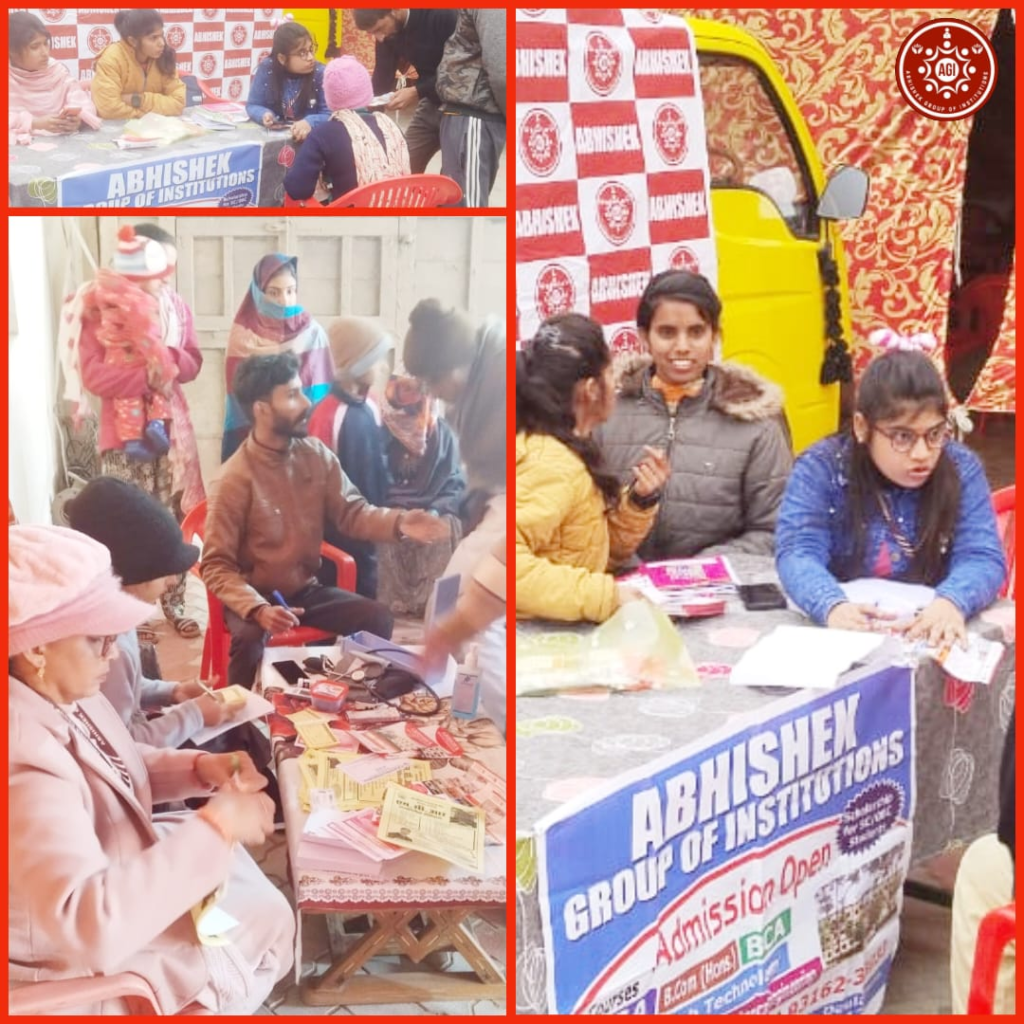
9) विश्व हिंदी दिवस 2024
हिंदी भारत में सबसे ज्यादा बोली जाने वाली भाषा है। भारत के अलावा दुनिया के कई अन्य देशों में हिंदी भाषी लोग हैं, जो कम्युनिकेशन से लेकर अन्य जरूरतों के लिए हिंदी का प्रयोग करते हैं। ऐसे में आइए जानते हैं कि विश्व दिवस को मनाएं जाने का उद्देश्य क्या है?
विश्व हिंदी दिवस या विश्व हिंदी दिवस हर साल 10 जनवरी को मनाया जाता है। यह दिन हिंदी भाषियों के योगदान का सम्मान करने, भाषा के महत्व को समझने और लोगों को इसके महत्व के बारे में बताने के लिए मनाया जाता है। ऐसे में हम सभी को मिलकर निर्धारित तिथि पर विश्व हिंदी दिवस मनाना चाहिए ताकि युवा पीढ़ी को इसके बारे में पता चले।

विश्व हिंदी दिवस का इतिहास
1949 में संयुक्त राष्ट्र महासभा में पहली बार हिंदी बोली गई थी। 2006 में देश के तत्कालीन प्रधान मंत्री डॉ. मनमोहन सिंह ने पहला विश्व हिंदी दिवस मनाया था। तभी से 10 जनवरी को विश्व हिंदी दिवस या विश्व हिंदी दिवस मनाया जाने लगा। ऐसे में आपको भी इस तिथि को याद रखना चाहिेए। यदि आप जागरूकता पैदा करना चाहते हैं और युवा पीढ़ी को भाषा के बारे में अधिक जानकारी देना चाहते हैं तो इस दिन को मनाना महत्वपूर्ण है।
हिंदी दिवस का महत्व
हिंदी को भारत सरकार की आधिकारिक भाषा माना जाता है। यह भारत संघ की आधिकारिक भाषाओं में से एक है। आप भाषा के महत्व को बढ़ावा देकर और लोगों को अपने भाषणों, प्रदर्शनों, संगीत और थिएटर में हिंदी को शामिल करने के लिए प्रेरित करके विश्व हिंदी दिवस मना सकते हैं। हिंदी भारत में एक महत्वपूर्ण भाषा है और हर किसी को इस भाषा के बारे में खुद को और अधिक शिक्षित करने का प्रयास करना चाहिए। विश्व के सांस्कृतिक और भाषाई पहलू में भी हिंदी बहुत महत्वपूर्ण भूमिका निभाती है।
10)कब हुई प्रवासी दिवस की शुरुआत?
प्रवासी भारतीय दिवस की शुरुआत 2002 में तत्कालीन प्रधानमंत्री अटल बिहारी वाजपेयी के घोषणा के साथ हुई थी। भारत का मान बढ़ाने वाले भारतवंशियों को सम्मानित करने के लिए इस दिवस की शुरुआत की गई थी। पहली बार ये दिन 9 जनवरी, 2003 को सेलिब्रेट किया गया था।
दरअसल, 9 जनवरी की तारीख को इसलिए चुना गया है, क्योंकि इसी दिन 1915 में महात्मा गांधी दक्षिण अफ्रीका से भारत लौटे थे। देश वापसी करने के बाद उन्होंने भारत को आजाद कराने की जिम्मा उठाया और स्वतंत्रता संग्राम का नेतृत्व किया। उनके प्रयास से भारतीयों का जीवन और भविष्य दोनों ही बदल गया था।
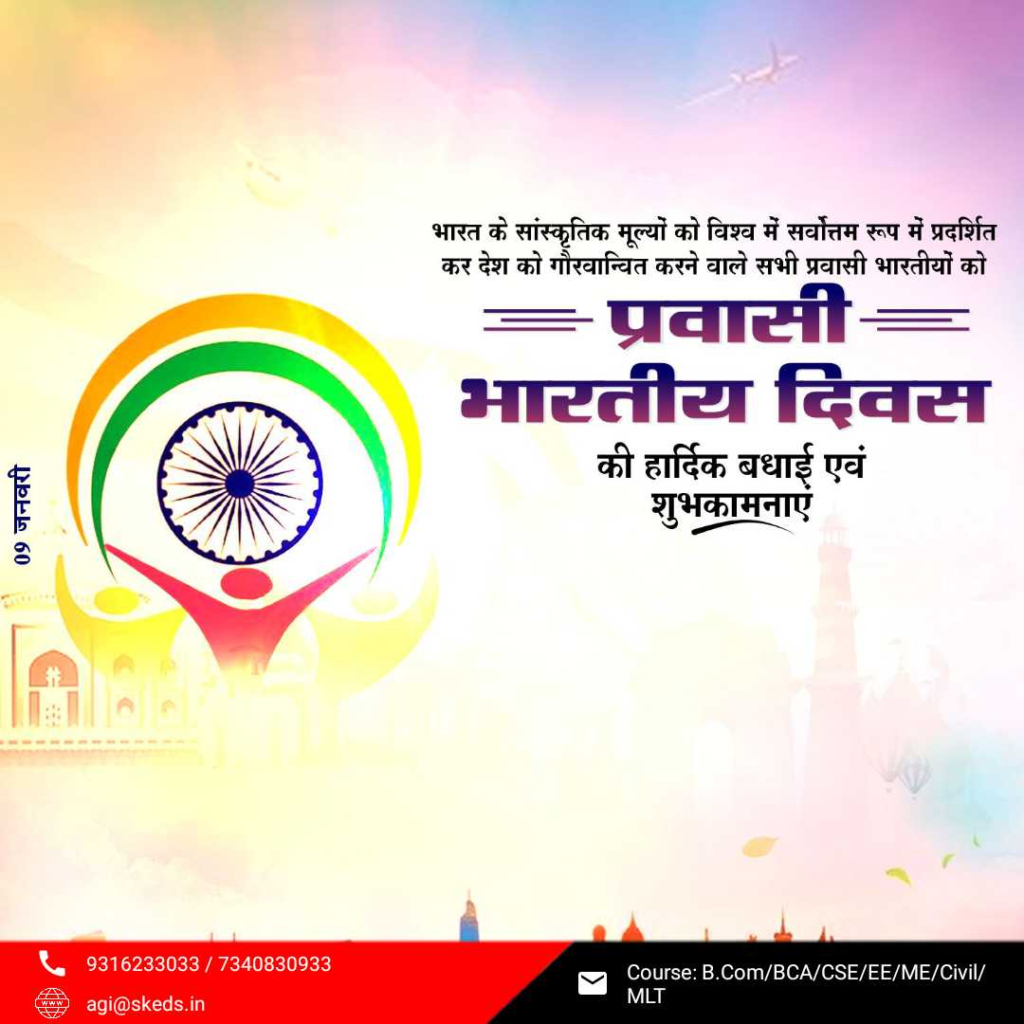
प्रवासी दिवस मनाने का उद्देश्य
इस दिन विदेशों में खास उपलब्धि हासिल करने वाले भारतीयों को सम्मानित किया जाता है। इस कार्यक्रम के जरिए भारत और प्रवासी भारतीयों के बीच एक पुल बनाने की कोशिश की जाती है। साथ ही, इसके जरिए विदेश निवेश को भी देश में बढ़ावा दिया जा सकता है।
11) National Cadet Corps(Drill Class)
Drill refers to a specific type of training or practice that involves precise and coordinated movements. It can be used in various contexts, such as military, sports, or even marching bands. In the case of NCC drill, it would involve training cadets in disciplined movements and formations.
12) किसानों के मसीहा कहे जाने वाले सर छोटू राम की आज (9 जनवरी) को पुण्यतिथि है.
किसानों के मसीहा कहे जाने वाले सर छोटू राम की आज (9 जनवरी) को पुण्यतिथि है. ब्रिटिश राज के दौरान भारत के किसानों की समस्याओं के निराकरण के लिए अंग्रेजों से भिड़ जाने वाले छोटू राम किसानों के बीच किसी देवता की तरह पूजे जाते हैं. भारतीय राजनीति में आज भी किसानों के हितों को लेकर किए गए उनके कामों की प्रासंगिकता बनी हुई है.
सर छोटू राम ने कहा था कि ‘किसान को लोग अन्नदाता तो कहते हैं, लेकिन यह कोई नहीं देखता कि वह अन्न खाता भी है या नहीं. जो कमाता है वही भूखा रहे यह दुनिया का सबसे बड़ा आश्चर्य है.’ सर छोटू राम को दीनबंधु के नाम से भी जाना जाता है. आइए जानते हैं कौन थे किसानों के मसीहा कहे जाने वाले सर छोटू राम, जिन्होंने अंग्रेजों को भी झुकने पर मजबूर कर दिया था.
पंजाब में जन्में रिछपाल, बने यूं बन गए छोटूराम
24 नवंबर 1881 को रोहतक के एक गांव गढ़ी सांपला में चौधरी छोटूराम का जन्म हुआ था. परिजनों ने उनका नाम रिछपाल रखा था, लेकिन घर में सबसे छोटे होने की वजह से सब उन्हें छोटू राम पुकारते थे. प्राथमिक स्कूल में नाम लिखाने के दौरान उनका यही नाम लिख दिया गया. जो आगे चलकर भी छोटू राम ही रहा. 11 साल की उम्र ही उनकी शादी ज्ञानो देवी से कर दी गई. छोटू राम आगे भी पढ़ाई करना चाहते थे, तो दिल्ली के एक ईसाई स्कूल में एडमिशन ले लिया. हालांकि, दिल्ली जाने से पहले हुई एक घटना ने उनके जीवन को एक नया मोड़ दिया
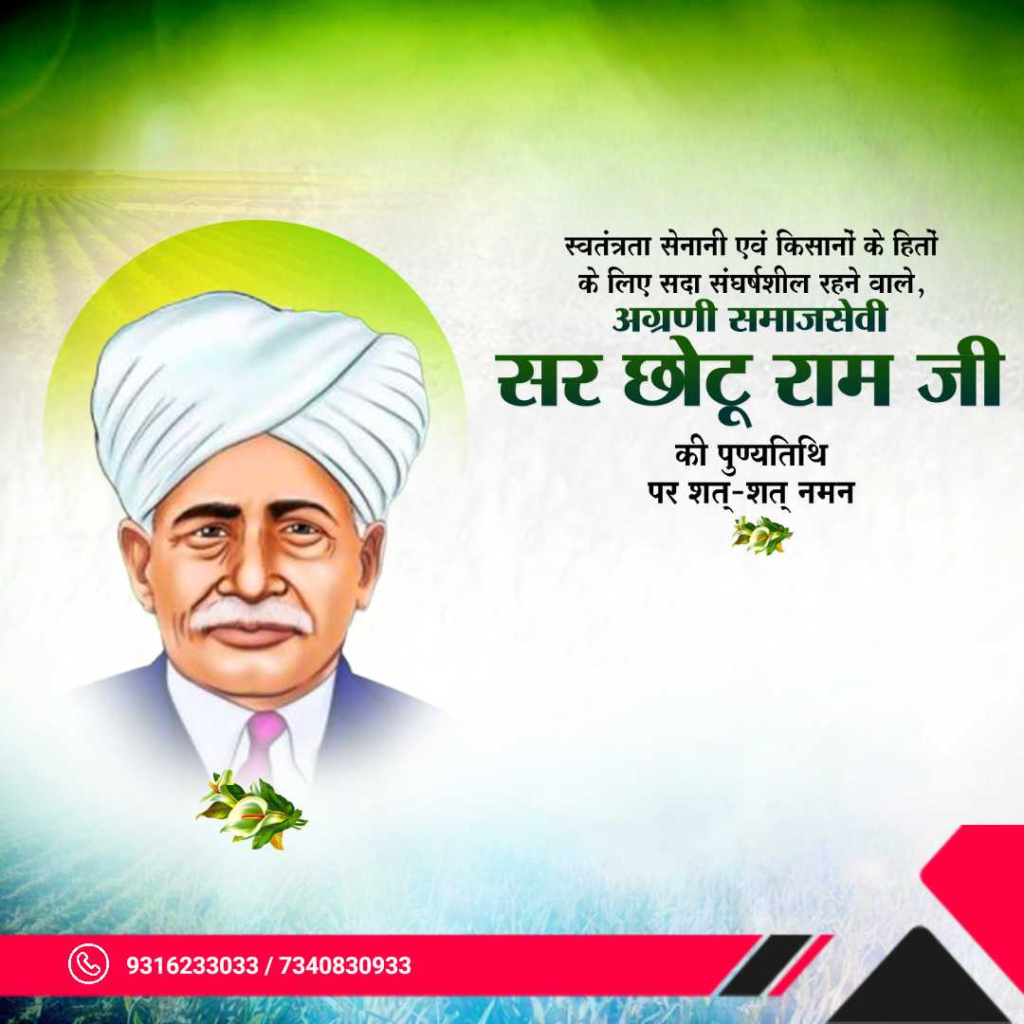
समाज सुधारक के तौर पर मिली पहचान
सर छोटू राम ने जाट आर्य-वैदिक संस्कृत हाई स्कूल खुलवाया. कहा जाता है कि अपनी आमदनी का एक बड़ा हिससा वो इस स्कूल में दान किया करते थे. शिक्षा के क्षेत्र में काम करने के साथ ही सर छोटू राम ने 1912 में जाट सभा का गठन किया. 1915 में ‘जाट गजट’ नाम से अखबार निकाल उसमें किसानों के लिए लेख लिखने के साथ किसानों की समस्याओं के हल के लिए पैरवी शुरू की. इतना ही नहीं, प्रथम विश्व युद्ध के समय उन्होंने रोहतक से 22 हजार से ज्यादा सैनिकों को सेना में भर्ती होने के लिए प्रेरित किया.
हिंदू, मुस्लिम सभी समुदायों में थी गहरी पकड़
1937 के पंजाब के प्रांतीय चुनाव में सर छोटू राम की पार्टी ने 175 में से 99 सीट पर जीत हासिल की. छोटू राम की हिंदू, मुस्लिम समुदाय में गहरी पैंठ थी और उन्हें जमीदारों का भी समर्थन प्राप्त था. वो पंजाब के विकास और राजस्व मंत्री बने. दीनबंधु छोटू राम ने किसानों के लिए क्रांतिकारी सुधार किए. उन्हें दो महत्वपूर्ण कानून पारित कराने का श्रेय दिया जाता है. इनमें से एक पंजाब रिलीफ इंडेब्टनेस, 1934 और दूसरा द पंजाब डेब्टर्स प्रोटेक्शन एक्ट, 1936 था. इन कानूनों में कर्ज का निपटारा किए जाने, उसके ब्याज और किसानों के मूलभूत अधिकारों से जुड़े हुए प्रावधान थे.
गिरवी जमीनों की मुफ्त वापसी जैसे कई अहम कानून कराए पारित
1938 में सर छोटू राम ने साहूकार रजिस्ट्रेशन एक्ट पारित करवाया. इसके साथ गिरवी जमीनों की मुफ्त वापसी एक्ट-1938, कृषि उत्पाद मंडी अधिनियम- 1938, व्यवसाय श्रमिक अधिनियम- 1940 और कर्जा माफी अधिनियम- 1934 कानून को भी पारित करवाया. 9 जनवरी, 1945 को सर छोटू राम का निधन हुआ था. केंद्र सरकार की ओर से लाए गए तीन कृषि कानूनों के खिलाफ किसान आंदोलन के दौरान भी सर छोटू राम का नाम खूब गूंजा था.
13) SWAMI VIVEKANAND JYANTI (National Youth Day)

14) Lohri Celebration at Abhishek Group of Institutions.
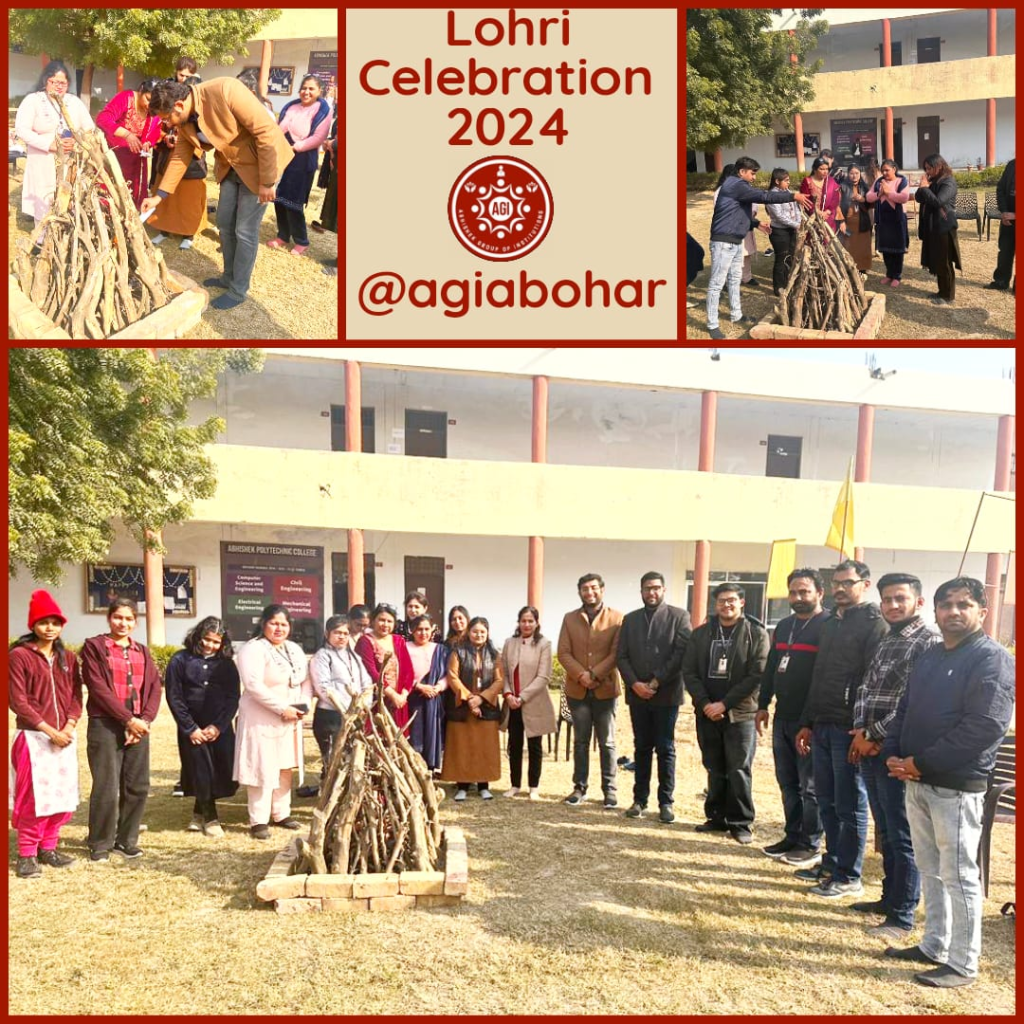
Lohri Celebration
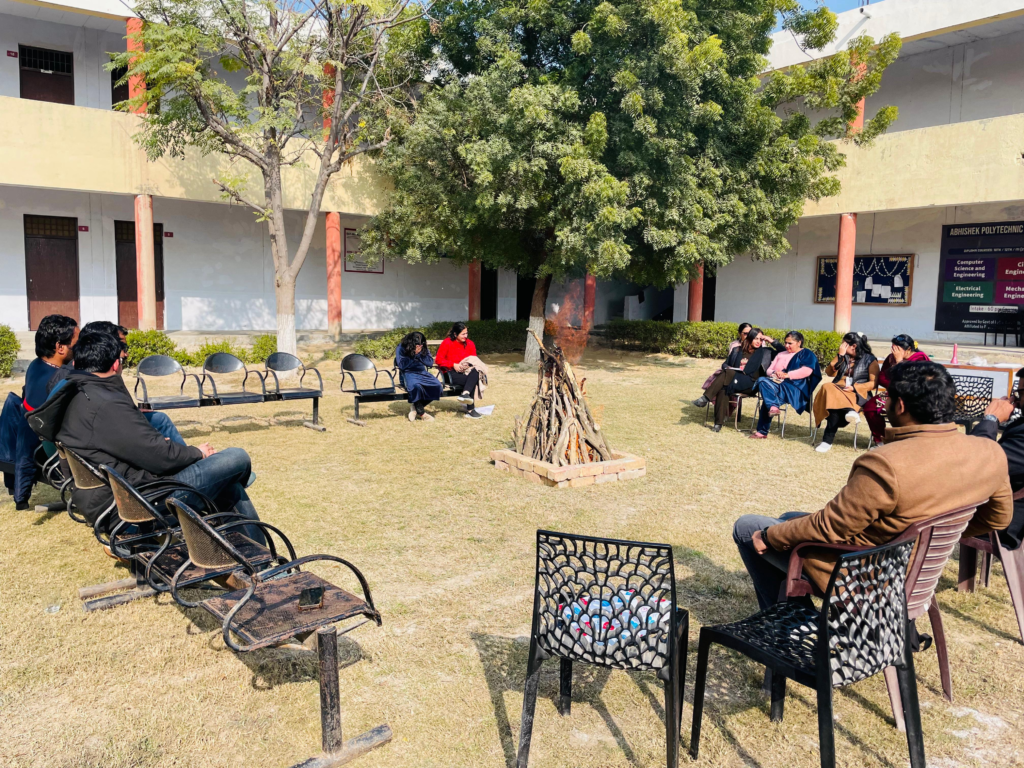
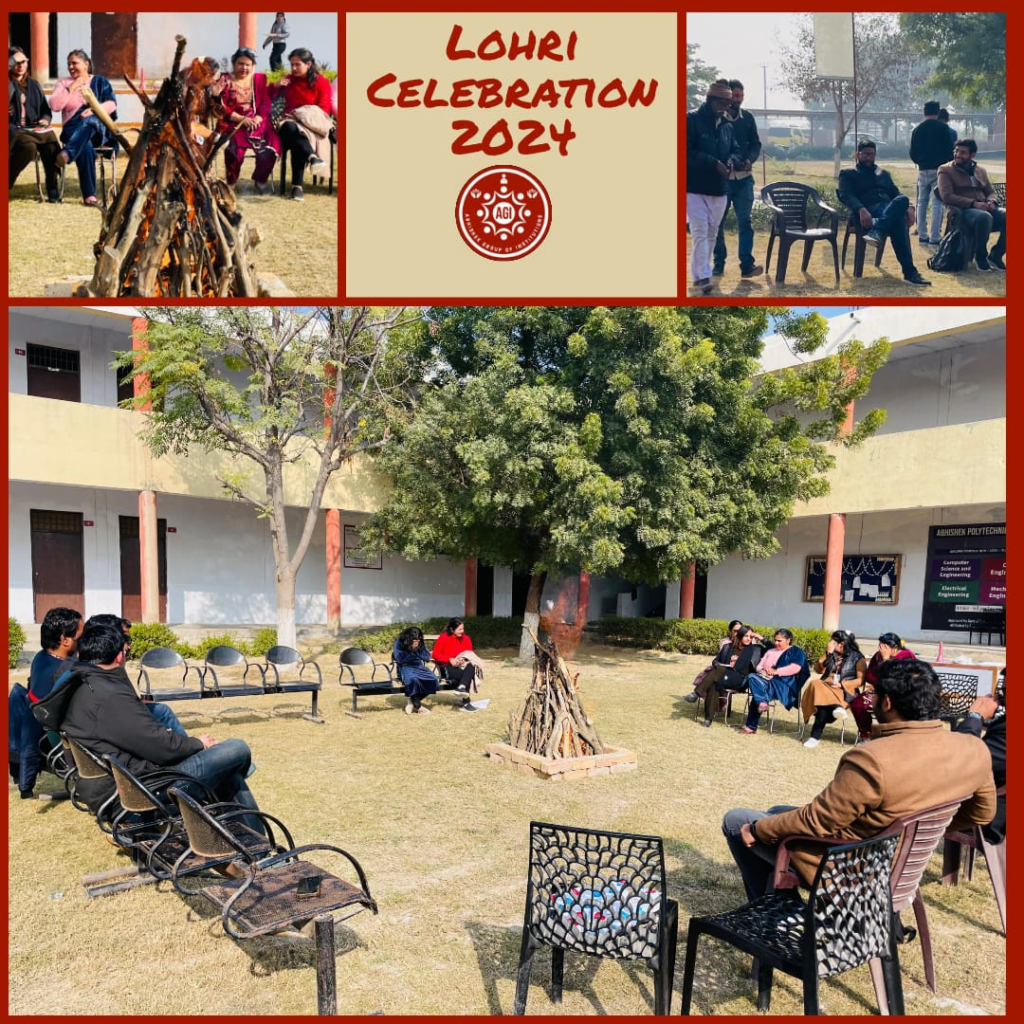
15) Campus Cleaning by Volunteers
Campus Cleaning

AGI

16) Indian Army day
Why is Indian Army Day celebrated on January 15?
Army Day is celebrated on this day to remember General (later Field Marshal) KM Cariappa taking over the command of the Indian Army from General Sir FRR Bucher, the last British Commander-in-Chief in 1949. He became the first Indian Commander-in-Chief of Independent India.
The Chief of Army Staff has announced that the Indian Army will observe the year 2024 as the ‘Year of Technology Absorption,’ a theme that underscores the Army’s focus and efforts to leverage technology as a catalyst for transformative change.
“The character of warfare continues to change. To prepare ourselves for the future, we set into motion a holistic transformation process last year. We have made good progress and many milestones have been achieved. Our capability development
endeavours stand on the edifice of Atmanirbharta, to which we are firmly committed. The transition towards becoming a modern, agile, adaptive and technology-enabled future-ready force shall continue as part of the Transformation Roadmap,” General Manoj Pande, Chief of Army Staff.

Tribute by PM Modi and others on Indian Army Day:
Gen Manoj Pande, PM Modi, President Droupadi Murmu and others have taken to social medai to extend their wishes to the armed forces on this day.
Earlier, Gen Manoj Pande paid homage to soldiers who laid down their lives in service to the nation on the Army Day.
“On the occasion of Army Day 2024, I convey my felicitations and warm wishes to all ranks of the Indian Army, civilian employees, Veterans and their families. We solemnly remember and pay homage to our comrades who have laid down their lives in service of the nation. Their supreme sacrifice shall always inspire us,” he said.
President Droupdai Murmu and Prime Minister Narendra Modi conveyed their warm wishes to Indian Army personnel on the occasion of Army Day on January 15.
The President who is the Supreme Commander of the Armed forces in her address to the Indian Army said, “I extend my warm felicitations to the Indian Army on the occasion of Army Day 2024.”
“The Indian Army plays a pivotal role in ensuring the country’s security. The Indian Army has always displayed professionalism during conflicts, ..
17) Republic Day Celebration at Abhishek group of Institutions
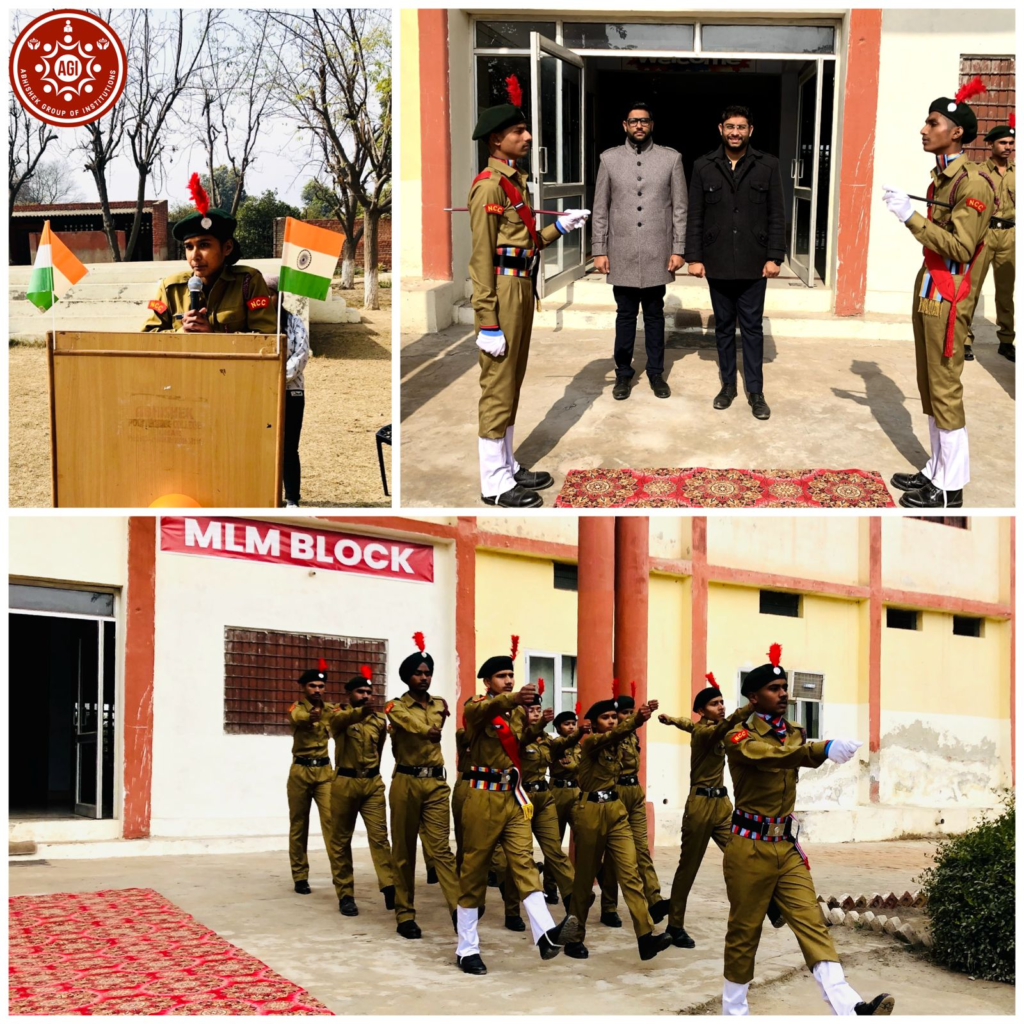
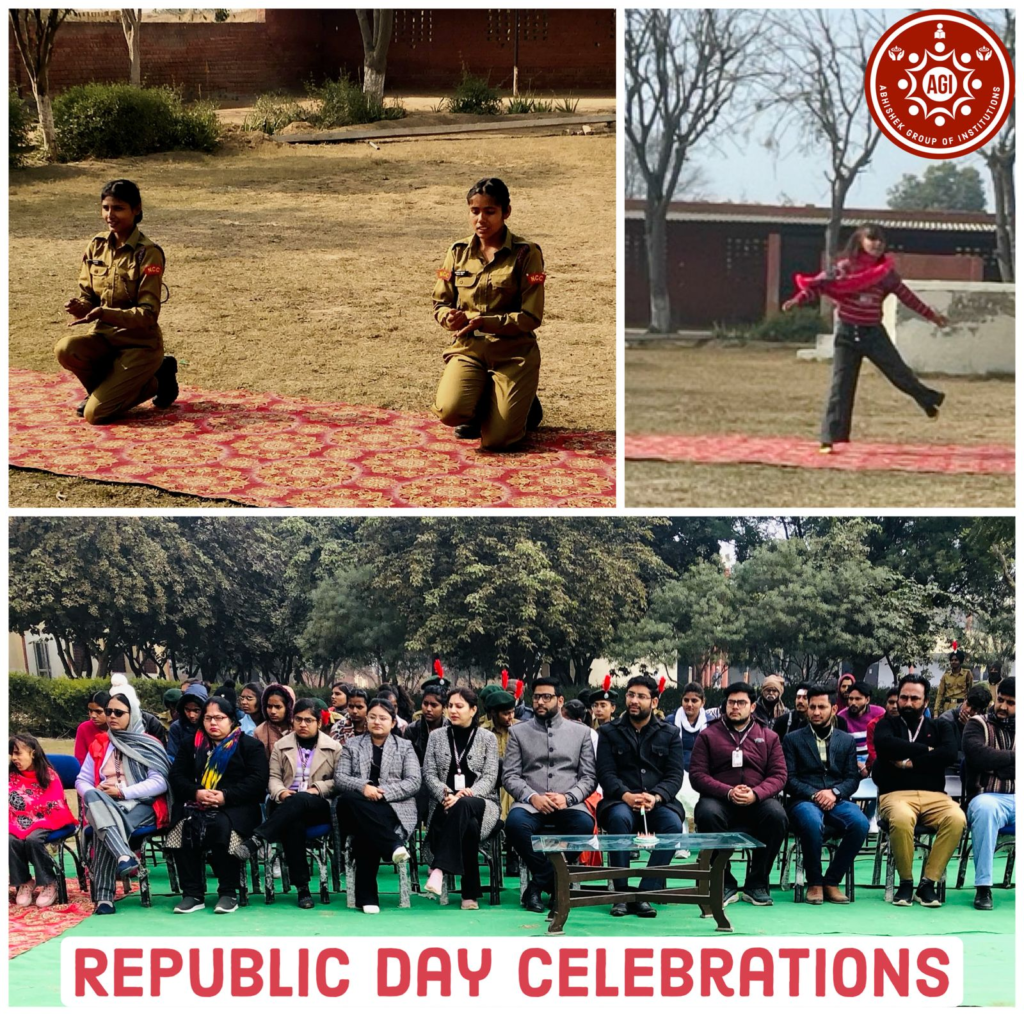
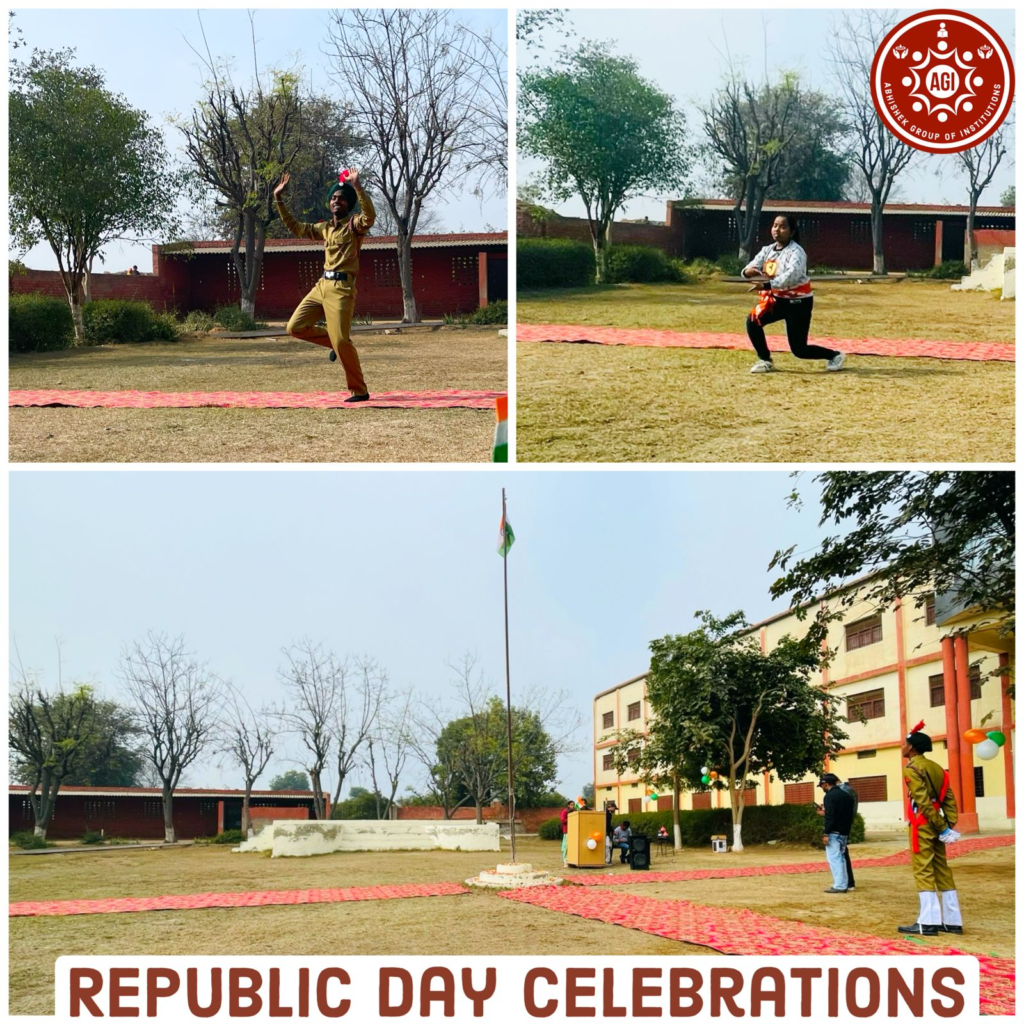
18) Guru Gobind Singh ji Jyanti
Guru Gobind Singh Jayanti Celebration
The special time of the year is here. Every year, Guru Gobind Singh Jayanti is celebrated with a lot of pomp and grandeur in India, by the Sikh community. One of the largest festivals of Punjab, Guru Gobind Singh Jayanti is the birth anniversary of Guru Gobind Singh, the last and the tenth human guru of the Sikhs. Guru Gobind Singh was a warrior, poet and a philosopher. His ideas and teachings are worshipped by the Sikh community. On Guru Gobind Singh Jayanti, people narrate tales of his bravery, learn his teachings and philosophies and try to walk the path showed by the Guru.
History:
Guru Gobind Singh was born in Patna, Bihar. According to the Julian calendar, he was born on December 22, 1666. However, Julian calendar is not followed anymore. Mughal Emperor Aurangzeb beheaded Guru Gobind Singh’s father Guru Tegh Bahadur for not accepting Islam as their religion. Guru Gobind Singh’s mother was Mata Gujri. The place where Guru Gobind Singh was born is known as Takhat Shri Harimander Ji Patna Sahib now. 1676, at the age of nine, Guru Gobind Singh was declared the tenth guru of Sikhs, on the day of Baisakhi.

Significance:
Guru Gobind Singh was a poet and a writer. He also founded the Khalsa Panth. Khalsa strictly followed the spiritual discipline under the guidance and supervision of Guru Gobind Singh. He announced Guru Granth Sahib as the permanent Guru for the Sikh community prior to his death in 1708. On this day, people visit Gurudwaras and celebrate the birth anniversary of Guru Gobind Singh.
19) National Girl Child Day
National Girl Child Day 2024: It is observed on 24 January to spread awareness about the inequalities faced by girls in Indian society, and also to promote awareness about the rights of the girl child and the importance of female education, health, and nutrition. The day is in line with various campaigns and programs of the Indian government including Beti Bachao Beti Padhao and Save the Girl Child.
The objective behind celebrating National Girl Child Day is to provide support and opportunities to the girls of India. As we know in India, gender inequality is one of the major issues that needs to be focused on and it exists in several areas including legal rights, education, medical care, marriage, etc. Female foeticide is another major issue that further affects the demographic problems in India.
No doubt, the step of the Government of India to celebrate National Girl Child Day is an improvement mission for young girls and also a promotion of the significance of girls as a child.
National Girl Child Day 2024 Objectives
- To increase the consciousness of the people and offer new opportunities to the girl child in society.
- To remove all the inequalities faced by the girl child.
- To ensure that the girl child should get all their human rights, respect, and value in the country.
- To work on gender discrimination, and to educate people.
- To work against diminishing child sex ratio in India and change the mind of the people regarding girls as children.
- To increase awareness about the importance and role of the girl child.
- To provide opportunities to girls and rights for their betterment.
- To educate people about the health and nutrition of a girl.
- To provide equal rights and allow them to move to any part of the country.
National Girl Child Day 2024: Rights of a Girl Child in India
Various schemes are mentioned by the Government of India to make the living status of the girl child better. Some of the schemes are as follows:
- The determination of sex in clinics during pregnancy has been blocked by the government.
- Child marriages of girls are restricted now.
- To save a girl child a scheme namely “Save the Girl Child” has been introduced by the government.
- Free and compulsory education for both boys and girls till 14 years of age has improved the education of girl children.
- To fight malnutrition, high illiteracy, poverty, and infant mortality in society, antenatal care has been made necessary for all pregnant women.
- Many Laws are made by the Government like Anti-Sati, and Anti-MTP to make women get employment and status to the Women.
- To give equal rights and opportunities to girls’ several rules are made by the government for the betterment of the future.
19) International day of Education
UNESCO is dedicating the International Day of Education celebrated on 24 January 2024 to the crucial role education and teachers play in countering hate speech, a phenomenon which has snowballed in recent years with the use of social media, damaging the fabric of our societies.
The world is seeing a surge of violent conflicts paralleled by an alarming rise of discrimination, racism, xenophobia, and hate speech. The impact of this violence transcends any boundary based on geography, gender, race, religion, politics, offline and online. An active commitment to peace is more urgent today than ever: Education is central to this endeavor, as underlined by the UNESCO Recommendation on Education for Peace, Human Rights and Sustainable Development. Learning for peace must be transformative, and help empower learners with the necessary knowledge, values, attitudes and skills and behaviours to become agents of peace in their communities.

© UNESCO
“Because if hatred starts with words, peace starts with education. What we learn changes how we view the world and influences how we treat others. Education must therefore be at the heart of our efforts to achieve and maintain world peace.”
On the occasion of International Day of Education, Audrey Azoulay, UNESCO Director-General, “Education is a fundamental human right. It’s the bedrock of societies, economies, and every person’s potential. But without adequate investment, this potential will wither on the vine. It has always been shocking to me that education has been given such a low priority in many government policies and in international cooperation instruments. The theme of this year’s International Day of Education reminds us that “to invest in people, prioritize education.” Investment is critical to achieving Sustainable Development Goal 4.
Last year’s Transforming Education Summit gathered the world together to reimagine education systems so every learner accesses the knowledge and skills required to succeed. Over 130 countries made commitments to ensure that universal quality education becomes a central pillar of public policies and investments. A Call to Action on Educational Investment and the establishment of the International Financing Facility for Education created a fresh push on domestic and international financing.
And the Summit launched a range of global initiatives to mobilize support for education in crisis settings, girls’ education, foundational learning, transforming teaching, digital tools, and green education systems. Now is the time for all countries to translate their Summit commitments into concrete actions that create supportive and inclusive learning environments for all students.
20) Lala Lajpat Rai Birth Anniversary
लाला लाजपत राय ने एक राष्ट्रवादी राजनेता, वकील और लेखक के रूप में भारत को अपना अमूल्य योगदान दिया। वह आर्य समाज से प्रभावित थे जिसका उन्होंने देशभर में प्रचार प्रसार किया।
‘पंजाब केसरी’ कहे जाने वाले लाला लाजपत राय भारतीय स्वतंत्रता संग्राम के प्रमुख नायकों में से एक थे। उनकी भारत को आजादी दिलाने में अहम भूमिका थी। इसके साथ ही उन्होंने एक आदर्श नेता के तौर अपनी पहचान बनाई। लाला लाजपत राय की आज 159वीं जयंती है। इस मौके पर हम आपको उनकी कुछ खास बातें बताते हैं जिसके बारे में शायद ही लोग जानते होंगे।
लाला लाजपत राय ने एक राष्ट्रवादी राजनेता, वकील और लेखक के रूप में भारत को अपना अमूल्य योगदान दिया। वह आर्य समाज से प्रभावित थे जिसका उन्होंने देशभर में प्रचार प्रसार किया है। पंजाब में उनके कार्यों की वजह से उन्हें पंजाब केसरी की उपाधि दी गई।
लाला लाजपत राय ने स्वामी दयानंद के साथ मिलकर आर्य समाज की स्थापना की। वह एक बैंकर भी थे, जिन्होंने देश में एक स्वदेशी बैंक की स्थापना की थी, जिसे हम आज पंजाब नेशनल बैंक के नाम से जानते हैं। लाला लाजपत राय आज भी करोड़ों युवाओं के प्रेरणा स्रोत हैं।
ब्रिटिश हुकूमत के खिलाफ लाला लाजपत राय को बर्मा की जेल में भी रहना पड़ा। जेल से वापस आने के बाद साल 1970 में वह अमेरिका के दौरे पर गए और प्रथम विश्व युद्ध के दौरान वापस आए। 28 जनवरी, 1856 को जन्में लाला राजपत राय के पिता राधाकृष्ण अग्रवाल एक अध्यापक थे और प्रसिद्ध लेखक थे। उनकी माता गुलाब देवी एक गृहणी थीं। वह एक मेधावी छात्र रहे। उन्होंने अपनी पढ़ाई पूरी करने के बाद वकालत की पढ़ाई की और हिसार से वकालत शुरू की।
हालांकि अंग्रेजी सरकार की न्याय व्यवस्था को देखकर उनके मन में क्रोध पैदा हो गया। इसकी वजह से वह वकालत छोड़कर बैंकिग क्षेत्र में आ गए और अपनी आजीविका चलाने के लिए बैंकों का नवाचार शुरू किया। बाल गंगाधर तिलक के बाद वह उन शुरुआती नेताओं में शामिल थे, जिन्होंने पूर्ण स्वराज्य की मांग उठाई थी।
1905 में बंगाल विभाजन के बाद वह सुरेंद्रनाथ बनर्जी और विपिनचंद्र पाल जैसे आंदोलनकारियों से मिल गए और अंग्रेजी सरकार के इस फैसले का विरोध किया। उन्होंने पूरे देश में स्वदेशी आंदोलन को बढ़ाने में मदद की। उनकी लोकप्रियता को देखकर अंग्रेजों के अंदर डर पैदा हो गया था। इसकी वजह से अंग्रेजों ने लाला लाजपत राय को गिरफ्तार कर लिया और बर्मा के जेल में डाल दिया।

पंजाब केशरी नाम से हुए मशहूर
ब्रिटिश राज के दौरान लाला लाजपत राय की बात को पंजाब में हर कोई मानता था। पंजाब में उनके प्रभाव की वजह से ही उन्हें पंजाब केशरी यानी पंजाब का शेर कहा जाता था। पंजाब में ब्रिटिश राज के खिलाफ लाला लाजपत राय ने आवाज उठाई थी।
17 नवंबर 1928 को लाहौर में साइमन कमिशन के खिलाफ विरोध के दौरान लाठी चार्ज में वह घायल हो गए, जिसके बाद उनका निधन हो गया। उनके निधन के बाद ब्रिटिश हुकूमत के खिलाफ देशभर में आक्रोष पैदा हो गया। महान क्रांतिकारी भगत सिंह, सुखदेव और राजगुरु ने लालाजी की मौत का बदला लेने के लिए अंग्रेज पुलिस अधिकारी सांडर्स को 17 दिसंबर 1928 को गोली से उड़ा दिया था।
21) National Girl Child Day 2024
It is observed on 24 January to spread awareness about the inequalities faced by girls in Indian society, and also to promote awareness about the rights of the girl child and the importance of female education, health, and nutrition. The day is in line with various campaigns and programs of the Indian government including Beti Bachao Beti Padhao and Save the Girl Child.
The objective behind celebrating National Girl Child Day is to provide support and opportunities to the girls of India. As we know in India, gender inequality is one of the major issues that needs to be focused on and it exists in several areas including legal rights, education, medical care, marriage, etc. Female foeticide is another major issue that further affects the demographic problems in India.
No doubt, the step of the Government of India to celebrate National Girl Child Day is an improvement mission for young girls and also a promotion of the significance of girls as a child.
National Girl Child Day 2024 Objectives
- To increase the consciousness of the people and offer new opportunities to the girl child in society.
- To remove all the inequalities faced by the girl child.
- To ensure that the girl child should get all their human rights, respect, and value in the country.
- To work on gender discrimination, and to educate people.
- To work against diminishing child sex ratio in India and change the mind of the people regarding girls as children.
- To increase awareness about the importance and role of the girl child.
- To provide opportunities to girls and rights for their betterment.
- To educate people about the health and nutrition of a girl.
- To provide equal rights and allow them to move to any part of the country.
National Girl Child Day 2024: Rights of a Girl Child in India
Various schemes are mentioned by the Government of India to make the living status of the girl child better. Some of the schemes are as follows:
- The determination of sex in clinics during pregnancy has been blocked by the government.
- Child marriages of girls are restricted now.
- To save a girl child a scheme namely “Save the Girl Child” has been introduced by the government.
- Free and compulsory education for both boys and girls till 14 years of age has improved the education of girl children.
- To fight malnutrition, high illiteracy, poverty, and infant mortality in society, antenatal care has been made necessary for all pregnant women.
- Many Laws are made by the Government like Anti-Sati, and Anti-MTP to make women get employment and status to the Women.
- To give equal rights and opportunities to girls’ several rules are made by the government for the betterment of the future.
- Five Year Plans have been made by the government to look after the Education Status of the Backward States in India.
- The ‘Operation Blackboard’ has been created by the government for Girls by which every teacher gets Higher Education for making students better in education.
- Even several Balwadi creches ha ve been opened by the government for caring for babies and also making them visit primary schools.
- The government has introduced SHG or Self Help Groups to make the livelihood better for rural girls.
- The Open Learning System has been established for easiness to the girls of backward classes.
22) Republic Day 2024 (Congratulations From AGI family)
SH. AAKASH BANSAL (IAS) SDM, ABOHAR HONOURING OUR FACULTY MEMBER MR ARISH LOTA ON THE 75TH REPULBLIC DAY.
